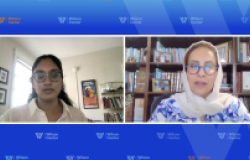Mexico Seeks to Empower Women in Politics
In addition to the well-touted economic reforms passed recently, this year Mexico approved a political reform package that, among other things, includes new measures aimed to ensure the greater participation of women in politics. The law now requires gender parity, which means that at least fifty percent of the candidates fielded by a political party in either federal or state legislative elections must be female. This begs the question as to whether there are enough women in the ranks to step up to the plate.

In addition to the well-touted economic reforms passed recently, this year Mexico approved a political reform package that, among other things, includes new measures aimed to ensure the greater participation of women in politics. The law now requires gender parity, which means that at least fifty percent of the candidates fielded by a political party in either federal or state legislative elections must be female. This begs the question as to whether there are enough women in the ranks to step up to the plate. Probably not, at this point, but the onus is now on the political parties to both encourage greater female participation and to invest in training women to either seek elected office or to serve as part of their party’s proportional representation in Congress (in Mexico’s Chamber of Deputies, 300 congresspersons are popularly elected, and 200 are assigned by their parties based on the percentage of the vote received in the election).
Mexico has a history of encouraging the participation of women in politics and has impressive rates of participation in the federal Congress. Women account for 38% of the legislators in Mexico’s lower house and 35% of the senators, rates in line with the Nordic countries (currently in the US, 18% of the seats in the House of Representatives and 20% of the Senate seats are filled by women). Mexico’s high rate of female participation is due in large part to previous affirmative action policies, which included several loopholes that the new law closes. Formerly, in order to comply with established quotas, women who were put on the ballot were later encouraged to cede their place to a male listed as a reserve replacement (oftentimes their husband) – the political party’s preference in the first place. Furthermore, women were included on the list to be assigned by their party under proportional representation but were so far down in the pecking order that they were rarely tapped to serve.
The new reform increases the quota requirement for candidates to 50%, with more stringent rules related to how the quota is implemented. Now, for example, the candidate and her replacement will have to be female. Furthermore, the National Electoral Institute (known as INE for its initials in Spanish) will ensure that women are not exclusively assigned to the districts in which the party in question has typically received the lowest percentage of the vote, a previous tactic that also diminished the impact of candidacy quotas.
Political parties of all stripes now find themselves with the task of finding women to incorporate into their ranks, and the clock is ticking: the new law will be in force for the upcoming mid-term congressional elections in July 2015.
Without a doubt, this new law represents a golden opportunity for women to get involved in politics – regardless of affiliation - and to influence the destiny of their communities. In discussing the issue with different party leaders, it is clear that they are all struggling with how to begin recruiting women from different areas of civil society, attracting those who are already considered community leaders. It would be wise for the parties to also invest in preparing the women in their ranks to most effectively serve. All of the parties have a budget for training, but it is not clear how much they will earmark specifically to the task of training potential female candidates.
Whether or not this will be a law that truly leads to greater female empowerment in politics will depend in large part on how each party approaches preparing its ranks, but they now have a legal obligation to ensure women take on a much larger role in their strategy. The presence of women in politics in Mexico and the increasing power of women in society more generally mean that appealing to women and strengthening their participation within the political parties may very well be a winning electoral strategy for the parties who learn to appeal to the female electorate more effectively. As Laura Torres (PRI), a state congresswoman from Baja California underscored, “more than half of the population is made up of women and the voice of Mexico is incomplete without their active political participation.”
Footnote: For years one of the most exclusive business organizations in Mexico was called the Mexican Council of Businessmen (el Consejo Mexicano de Hombres de Negocios). In June of this year, the organization decided to change its name to the Mexican Business Council after admitting into their exclusive club of 43 the very first woman, Blanca Treviño, the CEO of Softek. The Mexican private sector is much less diverse than the public sector – fewer than 1% of the CEOs in Mexico are female, and women are notoriously absent from the upper ranks of management – but this is indeed a small step in the right direction.
About the Author

Mexico Institute
The Mexico Institute seeks to improve understanding, communication, and cooperation between Mexico and the United States by promoting original research, encouraging public discussion, and proposing policy options for enhancing the bilateral relationship. A binational Advisory Board, chaired by Luis Téllez and Earl Anthony Wayne, oversees the work of the Mexico Institute. Read more









